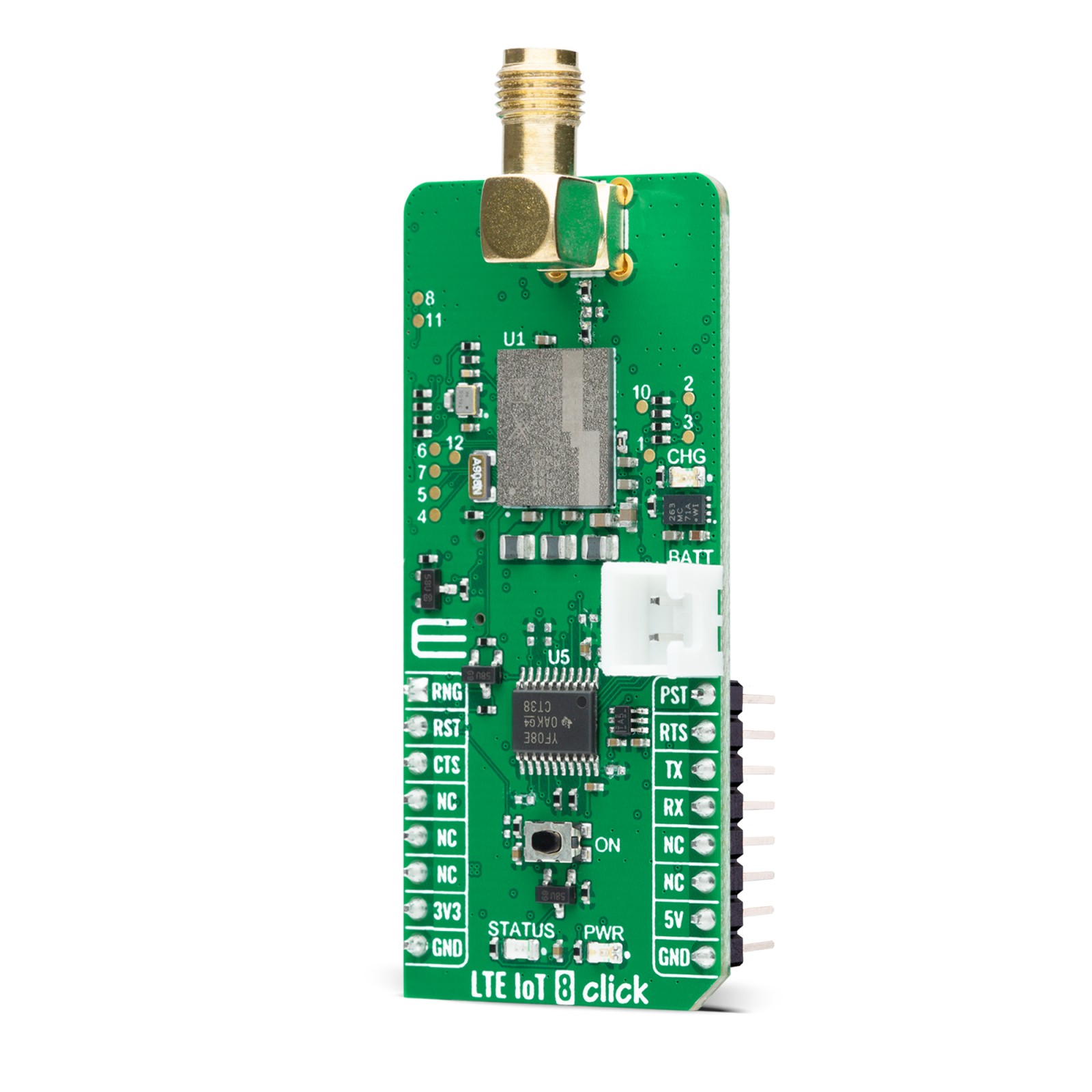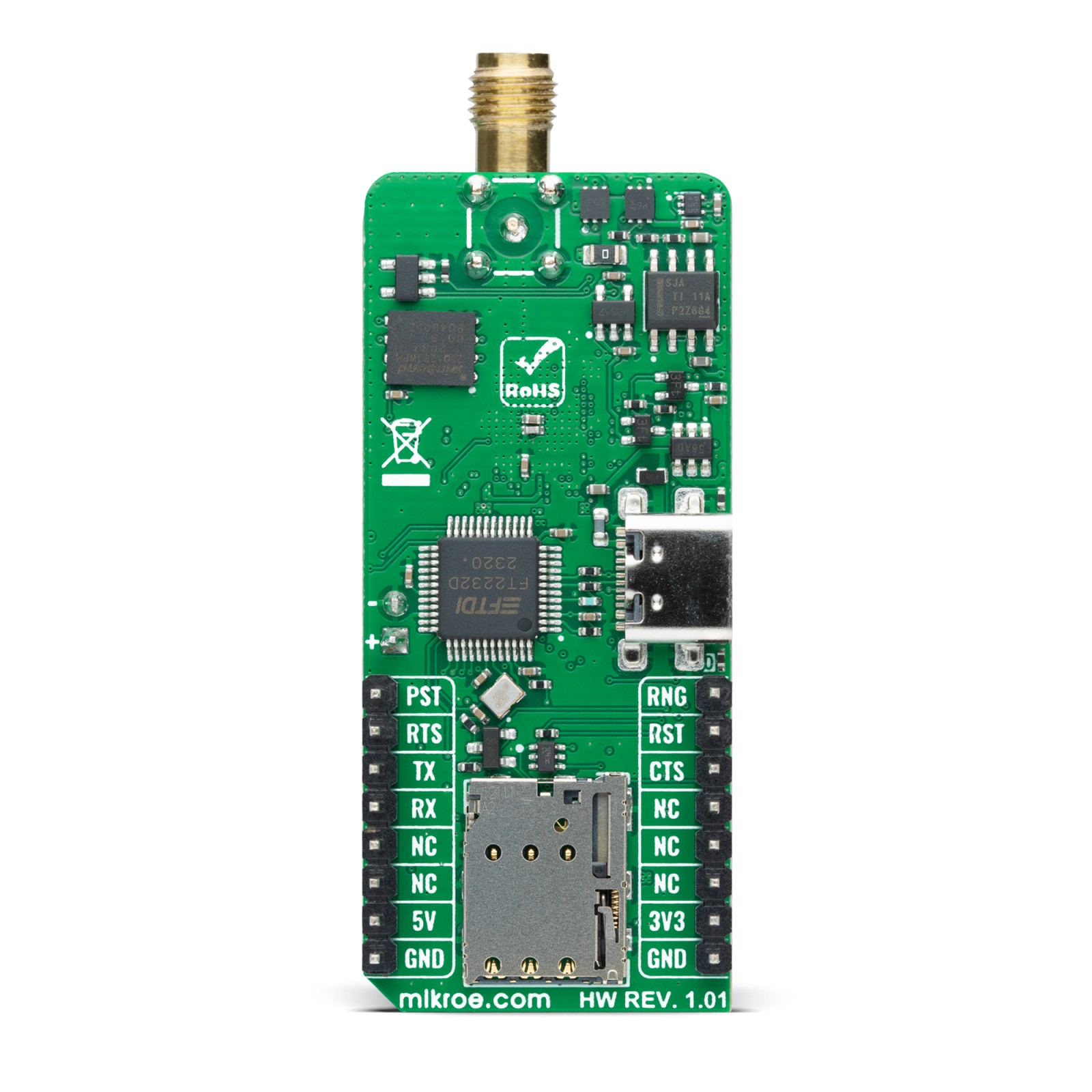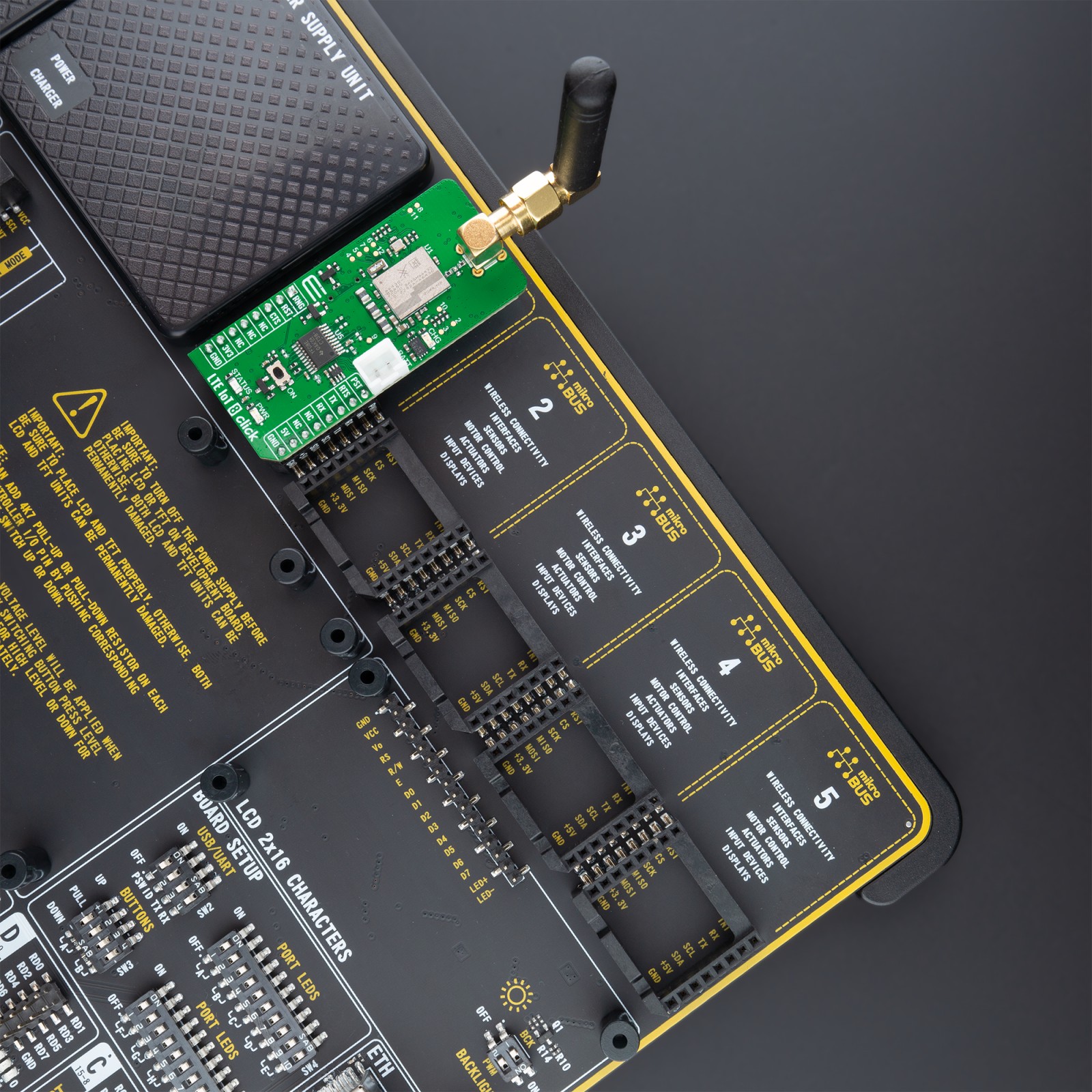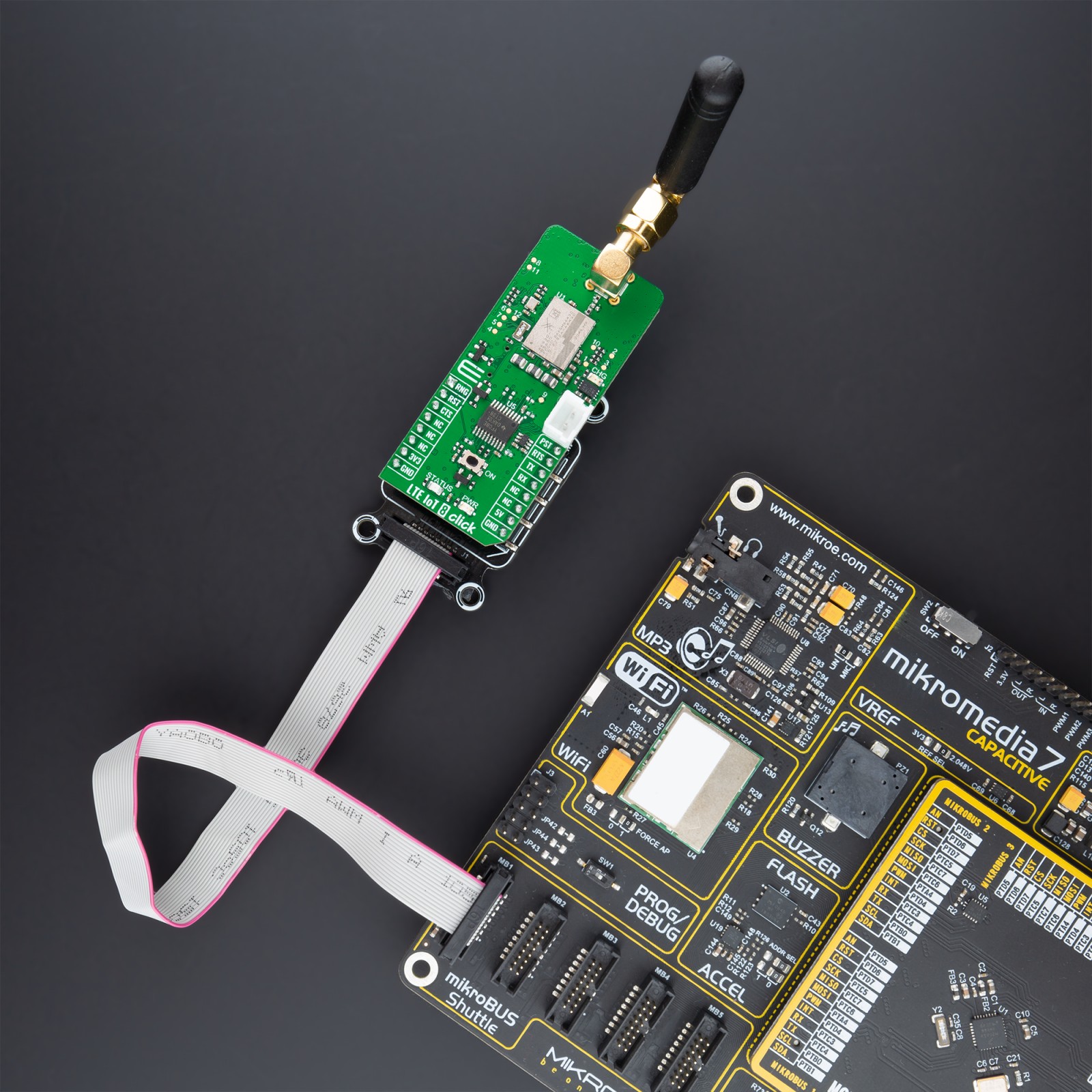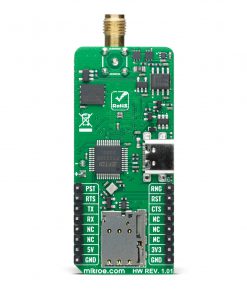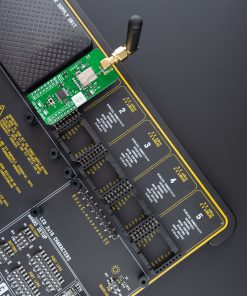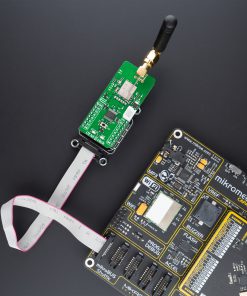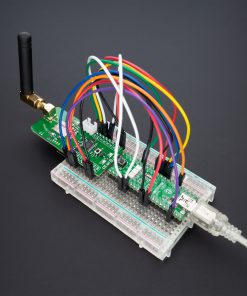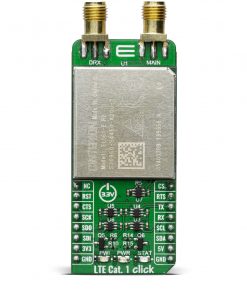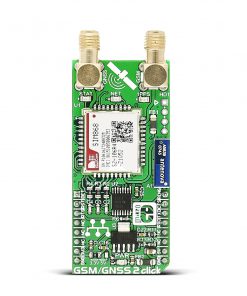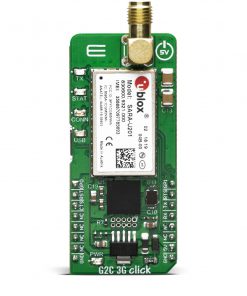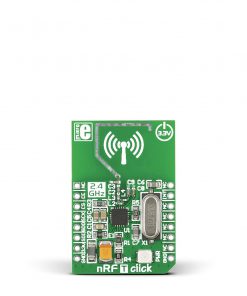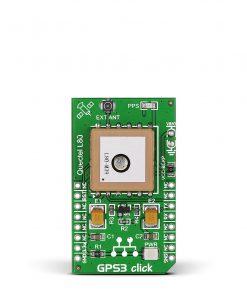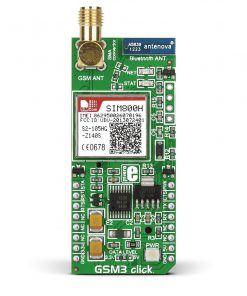LTE IoT 8 Click
R2,250.00 ex. VAT
LTE IoT 8 Click is a compact add-on board that contains a low-power solution for LTE and NB-IoT connectivity. This board features the SKY66430-11, a multi-band multi-chip System-in-Package (SiP) supporting 5G Massive IoT (LTE-M/NB-IoT) platforms from Skyworks. The SiP integrates the entire RF front end, transceiver, power management, memory, and baseband modem for an LTE multi-band radio operating in the 698 to 2200MHz frequency range. According to Skyworks, the SKY66430-11 is a fully pre-certified, all-in-one SiP that supports a range of low power, low data rate consumer and industrial IoT applications, including asset tracking, industrial monitoring, smart metering, and wearables.
LTE IoT 8 Click is supported by a mikroSDK compliant library, which includes functions that simplify software development. This Click board™ comes as a fully tested product, ready to be used on a system equipped with the mikroBUS™ socket.
Stock: Lead-time applicable.
| 5+ | R2,137.50 |
| 10+ | R2,025.00 |
| 15+ | R1,912.50 |
| 20+ | R1,840.50 |
How does it work?
LTE IoT 8 Click as its foundation uses the SKY66430-11, 5G Ready IoT SiP, compact low-power solution for LTE-M and NB-IoT connectivity in wearables, asset tracking, industrial monitoring, and smart metering from Skyworks Solutions and Sequans Communications. The SiP integrates the RF front-end, transceiver, baseband modem, memory, and power management and provides 18 bands from 698 to 2200MHz. It is pre-certified with major network operators, regulatory agencies, and standards organizations for fast global deployment. The device offers up to 300kbps download and 375kbps upload, and it supports Positioning over LTE.

It also has the best-in-class “Deep Sleep” power consumption of 1uA, representing a significant benefit for battery-powered IoT devices. Besides, it features a 100% software-based low power secure positioning solution that works anywhere (enables location deep indoors where GPS doesn’t work).
The SKY66430-11 communicates with MCU using the UART interface with commonly used UART RX and TX pins with the hardware flow control pins UART CTS, RTS, RI (Clear to Send, Ready to Send, and Ring Indicator). It operates at 115200 bps by default configuration to transmit and exchange data with the host MCU. It is also equipped with a USB type C connector, which allows the module to be powered and configured by a personal computer (PC) using FT2232D, a compact USB to a serial UART interface device designed to operate efficiently with USB host controllers.
This Click board™ can be battery-powered and used as a stand-alone device. It also contains the MC34671, a fully-integrated Li-Ion or Li-Polymer battery charger allowing a battery charge when Click board™ is inserted in mikroBUS™ socket or plugged into a USB port with the CHG LED indicator used as an indicator of the charging progress. CHG LED will turn off once the battery charging is finished.
Also, this Click board™ has an additional yellow LED labeled as STAT that indicates different operating modes of the module, while the PWM pin on the mikroBUS™ socket is used as Power Saving Status indicator. This indicator is set to a high logic state when the modem is in an active state or low logic state when the modem is in low power mode. An onboard pushbutton labeled ON is routed to the RST pin on the mikroBUS™, representing the Ignition button.
LTE IoT 8 Click has the SMA antenna connector with an impedance of 50Ω used for connecting the appropriate antenna that Mikroe has in its offer. Besides the LTE SMA connector, this Click board™ also has a Nano-SIM card slot that provides multiple connections and interface options.
This Click board™ can operate with both 3.3V and 5V MCUs. A proper logic voltage level conversion is performed by appropriate voltage level translator TXS0108E, while the on-board LDOs ensure that the recommended voltage levels power module. However, the Click board™ comes equipped with a library containing easy-to-use functions and an example code that can be used, as a reference, for further development.
For all additional support questions, the customers can submit a ticket to the official Sequans Support Cloud Portal page.
Specifications
Type
5G IoT,LTE IoT
Applications
Can be used in wearables, asset tracking, industrial monitoring, and smart metering.
On-board modules
SKY66430-11 – multi-band multi-chip System-in-Package (SiP) supporting 5G Massive IoT (LTE-M/NB-IoT) platforms from Skyworks Solutions
Key Features
Low power consumption, complete RF solution, supports 5G Massive IoT (LTE-M/NB-IoT) platforms, fully pre-certified, supports a range of low power, low data rate consumer and industrial IoT applications, and more.
Interface
UART
Feature
No ClickID
Compatibility
mikroBUS™
Click board size
L (57.15 x 25.4 mm)
Input Voltage
3.3V or 5V
Pinout diagram
This table shows how the pinout on LTE IoT 8 Click corresponds to the pinout on the mikroBUS™ socket (the latter shown in the two middle columns).
Onboard settings and indicators
| Label | Name | Default | Description |
|---|---|---|---|
| LD1 | PWR | – | Power LED Indicator |
| LD2 | CHG | – | Charging LED Indicator |
| LD3 | STATUS | – | Status LED Indicator |
| SW1 | ON | – | Module Power-On Button |
LTE IoT 8 Click electrical specifications
| Description | Min | Typ | Max | Unit |
|---|---|---|---|---|
| Supply Voltage | 3.3 | – | 5 | V |
| Operating Frequency Range | 698 | – | 2200 | MHz |
| Datarate Download Link | – | – | 300 | kbps |
| Datarate Uplink | – | – | 375 | kbps |
| Operating Temperature Range | -40 | +25 | +85 | °C |
Software Support
We provide a library for the LTE IoT 8 Click as well as a demo application (example), developed using MikroElektronika compilers. The demo can run on all the main MikroElektronika development boards.
Package can be downloaded/installed directly from NECTO Studio Package Manager(recommended way), downloaded from our LibStock™ or found on mikroE github account.
Library Description
This library contains API for LTE IoT 8 Click driver.
Key functions:
lteiot8_cfg_setup– Config Object Initialization function.lteiot8_init– Initialization function.lteiot8_default_cfg– Click Default Configuration function.
Examples description
The demo application is composed of two sections :
void application_task ( void )
{
switch ( example_state )
{
case LTEIOT8_CONFIGURE_FOR_CONNECTION:
{
if ( LTEIOT8_OK == lteiot8_configure_for_connection( ) )
{
example_state = LTEIOT8_WAIT_FOR_CONNECTION;
}
Delay_ms( 5000 );
break;
}
case LTEIOT8_WAIT_FOR_CONNECTION:
{
if ( LTEIOT8_OK == lteiot8_check_connection( ) )
{
example_state = LTEIOT8_CHECK_CONNECTION;
}
break;
}
case LTEIOT8_CHECK_CONNECTION:
{
if ( LTEIOT8_OK == lteiot8_check_connection_parameters( ) )
{
example_state = LTEIOT8_CONFIGURE_FOR_MESSAGES;
}
Delay_ms( 5000 );
break;
}
case LTEIOT8_CONFIGURE_FOR_MESSAGES:
{
if ( LTEIOT8_OK == lteiot8_configure_for_meesages( ) )
{
example_state = LTEIOT8_MESSAGES;
}
Delay_ms( 5000 );
break;
}
case LTEIOT8_MESSAGES:
{
lteiot8_send_meesage();
Delay_ms( 10000 );
break;
}
default:
{
log_error( &logger, " Example state." );
break;
}
}
}
The full application code, and ready to use projects can be installed directly from NECTO Studio Package Manager(recommended way), downloaded from our LibStock™ or found on mikroE github account.
Other mikroE Libraries used in the example:
- MikroSDK.Board
- MikroSDK.Log
- Click.LTEIoT8
Additional notes and informations
Depending on the development board you are using, you may need USB UART click, USB UART 2 click or RS232 click to connect to your PC, for development systems with no UART to USB interface available on the board. The terminal available in all MikroElektronika compilers, or any other terminal application of your choice, can be used to read the message.
mikroSDK
This Click board™ is supported with mikroSDK – MikroElektronika Software Development Kit. To ensure proper operation of mikroSDK compliant Click board™ demo applications, mikroSDK should be downloaded from the LibStock and installed for the compiler you are using.
For more information about mikroSDK, visit the official page.
Resources
Downloads
| Weight | 24 g |
|---|---|
| Brand | MikroElektronika |


